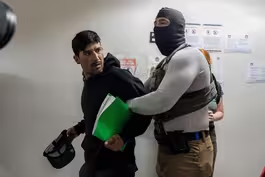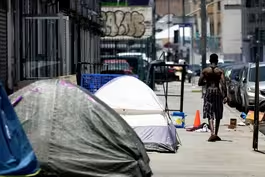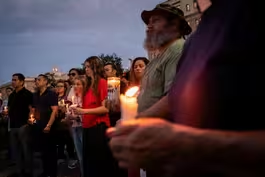
Meteorologist breaks down storm system behind Texas flooding
Clip: 7/8/2025 | 6m 5sVideo has Closed Captions
Meteorologist breaks down storm system behind historic Texas flooding
After the deadly flooding in Texas, there are questions about the weather forecasts and warning systems meant to save lives. Deema Zein spoke with meteorologist Matthew Cappucci of MyRadar.com about the origins of the storm and why it dumped so much water on the region.
Problems playing video? | Closed Captioning Feedback
Problems playing video? | Closed Captioning Feedback
Major corporate funding for the PBS News Hour is provided by BDO, BNSF, Consumer Cellular, American Cruise Lines, and Raymond James. Funding for the PBS NewsHour Weekend is provided by...

Meteorologist breaks down storm system behind Texas flooding
Clip: 7/8/2025 | 6m 5sVideo has Closed Captions
After the deadly flooding in Texas, there are questions about the weather forecasts and warning systems meant to save lives. Deema Zein spoke with meteorologist Matthew Cappucci of MyRadar.com about the origins of the storm and why it dumped so much water on the region.
Problems playing video? | Closed Captioning Feedback
How to Watch PBS News Hour
PBS News Hour is available to stream on pbs.org and the free PBS App, available on iPhone, Apple TV, Android TV, Android smartphones, Amazon Fire TV, Amazon Fire Tablet, Roku, Samsung Smart TV, and Vizio.
Providing Support for PBS.org
Learn Moreabout PBS online sponsorshipAMNA NAWAZ: Well, there are still a number of questions about the weather forecasts and why there weren't better warning systems that could have possibly saved lives.
Our Deema Zein spoke earlier with Matthew Cappucci, a senior meteorologist from MyRadar.com.
And she began by asking him about the origins of the storm itself and why it dumped so much water.
MATTHEW CAPPUCCI, Senior Meteorologist, MyRadar: We knew that we had ample moisture in place, absolutely tropical moisture content in the atmosphere.
Part of the reason for that was last Monday, Tamaulipas, Mexico got hit by Tropical Storm Barry.
Barry moved inland, dissipated, and then left this big blob of humidity that eventually wafted north into Texas.
So we knew the antecedent atmosphere conditions favored very heavy rain, but we didn't see much of a trigger.
And so that's why even more than 12, 24 hours out, yes, we thought there could be some isolated flooding, but we didn't think we'd see anything more than like six, seven inches, never mind a foot-and-a-half of water.
What wound up happening, though, was that as we headed towards Wednesday and Thursday, dying thunderstorms in West Texas left something called an MCV, or a mesoscale convective vortex, like this leftover whirlpool in the atmosphere, this little, teeny eddy.
And this invisible eddy, this little corridor of spinning air, parked over Texas Hill Country and did two things.
Number one, it helped focus moisture.
It gathered storms and really served as like the local trigger to get storms going.
And it wasn't moving, so those storms anchored in place.
And the other thing too, this thing was pulling in moisture from the south.
So you had an uninterrupted supply, a fire hose of tropical moisture from the Gulf that was aimed directly into these stagnant storms.
And it's July.
The upper-level winds are very weak.
The jet stream has retreated all the way to Canada.
So there's nothing to move these storms along either.
And so you got downpours lasting six, seven, eight hours, dumping three inches per hour.
Very quickly, some folks saw a foot to a foot-and-a-half worth of water.
DEEMA ZEIN: Was the storm actually what meteorologists thought that it would be, or did it move in a direction that they didn't even expect it to move?
MATTHEW CAPPUCCI: We knew the potential was there for some high-end flooding.
We didn't necessarily think the storm would stall for as long as it did.
And I think that's when things quickly became problematic.
And it was apparent right around midnight, 1:00 in the morning, as you headed into the Fourth of July, that something very bad was happening.
But by then, even though they were updating the forecast, they were issuing the warnings, a lot of folks were asleep.
And so even though the warnings went out and made folks cell phone squeal and trigger the wireless emergency alerts with the emergency alert system, I think a lot of people just had gone to bed not thinking much was going to happen.
And when they woke up, it was a completely different story.
There's no good way for a scientist or a communicator to convey a low-probability, high-impact event.
And so I think the forecasts were basically, yes, there could be some flooding.
There could be some locally bad flooding.
It wasn't until midnight into very early on the Fourth of July when warning operations really were like you know what is hitting the fan, that this is going to be a catastrophe.
So the warnings were good.
The forecasts were flawed.
The other frustrating thing too has been people trying to use this for political advantage, people saying, oh, DOGE cuts caused this flood.
No, typical National Weather Service forecast office staffing is like two to three meteorologists for this overnight shift.
They had five in place at the Weather Service in Austin, San Antonio.
They were staffed up.
They were doing their thing.
They knew in advance what was coming and they had folks there doing the job.
Staffing was not an issue.
If anything was an issue, the imperfect forecast going in may have been degraded by the reduction of weather balloons over parts of the Great Plains and the Midwest.
We have fewer balloons going up to get data because of budget cuts.
Then you have less data going into weather models and less accurate weather model simulations.
So that may have been a factor, but that's something we have to sort of iron out a little more.
DEEMA ZEIN: What can you tell people as a meteorologist on the situation and how it could be prevented and what really went wrong?
MATTHEW CAPPUCCI: This absolutely could have been prevented.
It doesn't take three hours to get to higher ground.
A lot of folks had two to three hours warning.
Many of the fatalities were children.
There needs to be a responsible adult who is making these decisions and keeping abreast of the weather.
There needs to be a plan in place ahead of time.
Every school, every camp in America should have a NOAA weather alert radio and have a plan for any type of alert that can come their way.
And so few people do.
And until we live as a more weather-ready society with these plans, taking these steps, listening to the warnings, I don't think anything's going to change.
DEEMA ZEIN: And this is always a question that has to be asked when big weather events like this occur, but was climate change a factor to the size of this storm?
MATTHEW CAPPUCCI: So that's a good question.
People always ask about climate change.
What I will say is this.
No event is caused by climate change.
There will always be floods in Flood Alley in Texas sporadically every couple years.
The atmosphere does have a greater capacity to hold a little more moisture these days because, as the environment warms, the air is like a sponge.
You add a little more moisture.
For every degree Fahrenheit the air temperature warms, the air can hold 4 percent more water.
And so that may have led to a bit of extra water coming down with this episode.
But I think trying to connect it to climate change is challenging, just given this was very unfortunate meteorology, very unfortunate and coincidental ingredients coming together.
And that will always be a thing.
Natural disasters will always happen.
It's only natural.
And so even though climate change is raising the ceiling a little bit, this was very much a natural disaster.
AMNA NAWAZ: Well, that was "News Hour"'s Deema Zein speaking earlier today with meteorologist Matthew Cappucci.
Meanwhile, just a short time ago, Texas Governor Greg Abbott was asked about problems with flood warnings on July 4.
In a testy exchange with reporters, the governor said he was not focused on blame, saying he would focus on solutions and the future instead.
GOP gives ICE massive budget to expand deportations
Video has Closed Captions
Clip: 7/8/2025 | 8m 34s | GOP gives ICE massive budget increase to expand Trump's deportation effort (8m 34s)
Homeless camp crackdown draws criticism from health experts
Video has Closed Captions
Clip: 7/8/2025 | 8m 50s | California's homeless encampment crackdown draws criticism from health experts (8m 50s)
New book 'On Her Game' chronicles rise of Caitlin Clark
Video has Closed Captions
Clip: 7/8/2025 | 7m 50s | Christine Brennan's new book 'On Her Game' chronicles rise of Caitlin Clark (7m 50s)
News Wrap: Netanyahu visits U.S. leaders amid ceasefire push
Video has Closed Captions
Clip: 7/8/2025 | 8m 53s | News Wrap: Netanyahu visits U.S. leaders as Trump administration pushes for Gaza ceasefire (8m 53s)
Texas region devastated by flooding shifts focus to recovery
Video has Closed Captions
Clip: 7/8/2025 | 6m 8s | Texas region devastated by flooding shifts focus to recovery as death toll tops 109 (6m 8s)
Trump tariff threat could impact relations with Asian allies
Video has Closed Captions
Clip: 7/8/2025 | 5m 43s | How Trump's tariff threats could impact relationship between U.S. and Asian allies (5m 43s)
Providing Support for PBS.org
Learn Moreabout PBS online sponsorshipSupport for PBS provided by:
Major corporate funding for the PBS News Hour is provided by BDO, BNSF, Consumer Cellular, American Cruise Lines, and Raymond James. Funding for the PBS NewsHour Weekend is provided by...

















